Canyoneering
Fishing
We have created this
page to answer common questions we have
received associated with our, Fishing Remote
Canyons page. Most of the questions have
been the same and rather then answering them
over and over, the information will be
placed here. Frankly I was surprised with
all the interest. I always thought I was a
loan weirdo out there, as no one in years
past ever showed any interest in this
strange pursuit.
Most of the creeks that hold wild
populations of fish require backpacking
trips into remote canyons. A canyon's
beauty itself has always been enough to draw
me into searching out new locations. Below
is an overview of what I do when pursuing
wild trout or other warm water fish in
remote canyons. It is not the only way. I'm
sure there are others out there that have
perfected it even more. My system has
evolved into a super simple, lightweight
method over the years and may not work for
everyone.
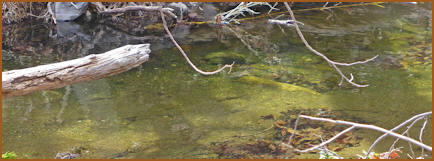
Can you find the two 13 inch rainbows in
this remote canyon creek? Always study a
pool first, before planning the best
approach.
The most common question we
have received, is to be more specific about
remote creeks locations, holding wild
trout/fish populations. I'll answer this
one right up front and say....sorry we are
not going to specific. I have already
listed how to find information on such
locations and posted a few. Others I have
not even posted because of their
sensitivity. I can recommend if one does not
want to search out areas, purchase the book,
Arizona Flyfisher's Guide by Will Jordan.
Will, actually mentions a couple of creeks I
wish he had not, but kept quite about so
many others thankfully. His book is a good
starting place for those new to Arizona or
this kind of crazy pursuit.
Fish
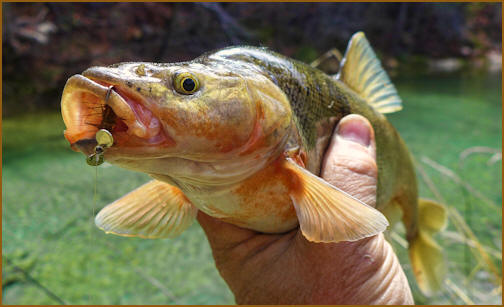
16" Chub
It seems most people want to pursue wild
trout. But I equally enjoy canyons that hold
warm water fish such as bass, sunfish, carp,
natives and catfish. Much of my pursuit in
Arizona is during the fall, winter and
spring, so I choose lower elevations usually
6000' or less during these times.
How Did Fish
Get There
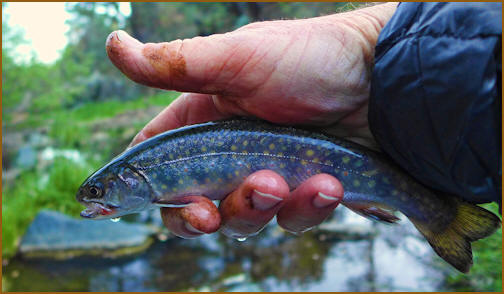
Yes, there are wild
populations of brook trout in AZ, Remote
Creek Central AZ
During the wet years of the 1980's the
Arizona Game and Fish Department inventoried
man made stock tanks around the state that
could sustain warm/cold water fish. They were
consequently stocked and many still remain,
incredible small fisheries. These stocking
records are still available to those
interested in pursuing them.
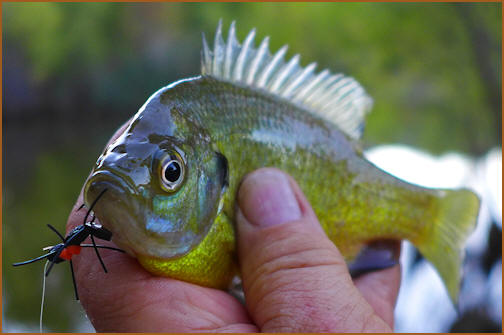
Sunfish occupy many remote warm water creeks
throughout Arizona. You will always find
them in pools, rather then moving water and
most dry flies work, even a big ugly
one, such as the one here.
The largest
sunfish I ever caught in AZ , was in a
remote stock tank about 30 miles east of
Bagdad. Consider checking out deep and
reliable stock tanks around AZ for fishing.
When these stock tanks flood they push fish
into canyons downstream. Thus the reason for
fish species being found in many
of the canyons listed and more. The same
applies to trout lakes at higher
elevations, again washing trout into canyons
below dams. This is also the reason why
stocking is no longer done in many
locations. The USFWS has concerns over this
impacting native fish populations
downstream. Another way fish make it into
these canyon creeks, is ranchers upstream
typically stock personal fishing ponds at
their ranches and again they find their way
downstream during wet years. One example of
such a drainage near Phoenix, is the upper
reaches of New River. Several large pools
exist containing sunfish.
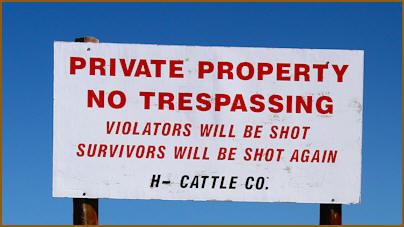
Respect private property rights
Native species
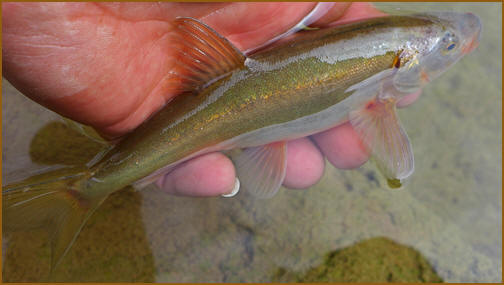
Some creeks have wild trout as well as
native chubs.
A few creeks and rivers have native
species within them. Many are closed to
fishing and others are mixed in with non
native fish. They may be caught accidentally
so be sure to release them unharmed
immediately. Some rivers and creeks are open
to fishing these gems such as Fossil Creek,
Salt and Verde Rivers. Again check
regulations.
Fish Size
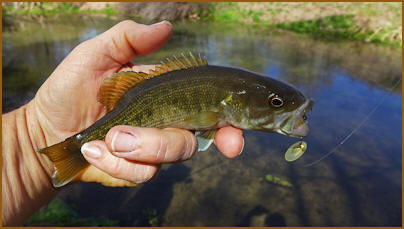
Largemouth Bass
Most small streams mean that the fish
will be small in size, although this is not
always the case. In small trout streams a
big one is 10 inches. Average are 6 to 8
inches. The same usually goes for bass,
around 10 inches. The only place this does
not hold true is with carp and brown trout.
They can grow big in deeper holes.

Bigger brown trout usually inhabit the best
places in a pool. Try there first.
Once the
creek gets wide and deeper the fish size
goes up. There was a time when big brown
trout captured my attention but today I'm
just as content catching smaller fish and
that usually translates into more fish also.
So I typically target these smaller streams
knowing I will be catching smaller fish.
Your interest may be different.
Regulations
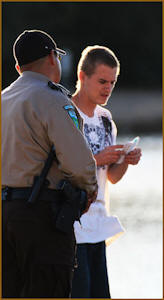
Remember to carry your fishing license
with you. You might be saying to yourself no
one will ever check me in such a remote
canyon. You never know. People were always
surprised when I contacted them in remote
areas over the years so carry a fishing
license.
Several of the rainbow trout streams I
fished many years ago have changed
regulations. The rainbows have been killed
and restocked with native trout. During
initial restocking they are typically closed
to fishing until they can sustain such
pressure. When researching a remote stream,
check the regs first.
Equipment

Screw in cleats aid with traction when
walking in slippery creeks. Unless the water
is super cold I normally don't use waders.
Instead quick drying pants and possibly a
second lightweight pair of sandals work
well.
Equipment questions were also a common
question and Ill list what I use. My system
has evolved through the years and today is
very simple and light. I've learned what
works and what doesn't and carry with me a
small assortment of the working stuff.
My
fishing systems are divided into 3 different
tackle arrangements.
- Small trout (below
12")
- Medium trout
(above 12 ") rainbows & browns, 3 weight
4 piece Sage rod
- Warm water fish
- Large brown
trout.
- Time of year
may dictate patterns or if crayfish are
present
Each is divided into plastic zip lock
bags and I simply pack the one needed for the
planned trip. Sometimes I carry both spin
and fly equipment, but only one rod. That
rod will be my TFO 1 weight with 6 small zip
ties. I use two zip ties to fasten the
spinning reel to the cork handle of the fly
rod. This actually works good for me and I
can switch back and forth between fly or
spin as needed.
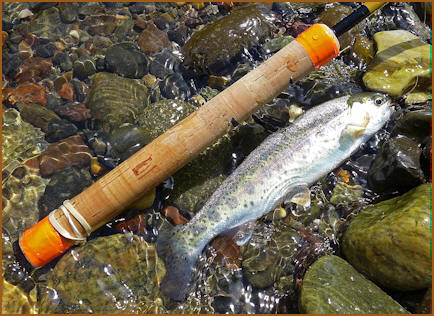
Tenkara rods (Japanese fly rods) work
well for this kind of canyoneering fly
fishing. They are very lightweight and fun
to fish with. I like the TFO's Cutthroat
model for small creeks shown above.
The fly fishing industry have done a very
good job of marketing their products and
convincing customers they "must have" lots
of equipment to ever begin to catch fish. On
top of that, good fly fishing equipment is
expensive. I too fell into the "got to have
all the latest greatest gear" years ago. Now
much of this equipment sits most of the time
and I use it to teach others fly fishing.
In reality, all one needs is a decent
rod/reel, some inexpensive fly line and a
few pieces of gear. I say inexpensive fly
line because most of your casts will not be
long, as many of these locations are very
brushy and chocked with rocks. A cheap
weight forward floating line will do. Also
important are good tactics and knowledge. By
simply reading one can become educated and
over time the experiences gained will make
you a better fisherman.
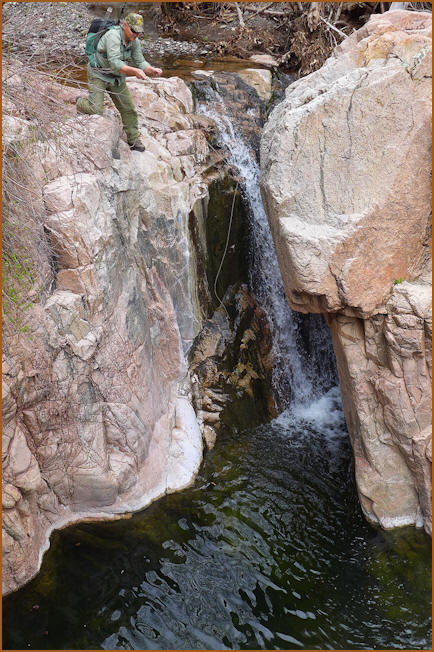
Waterfall pools are usually deep and
hold bigger fish. Try dangling a callibaetis
nymph imitation slowly into the pool from
above and don't fall in when you get a bite.
Have a plan on how to quickly get to your
fish after playing it.
When venturing into remote canyons in
search of fish I pack lightly. My trips
are usually an overnight or two because most
of these locations require miles of off
trail hiking. Sometimes more. Ben at
Arizona Wanderings does a very good job
outlining equipment also, so take at his
equipment system. His small stream fly
selection is a good choice. Create your own
with the style of fishing you enjoy. I
enjoy flyfishing the most but sometimes
leave the fly rod at home and choose a
spinning outfit for specific locations.
Wading
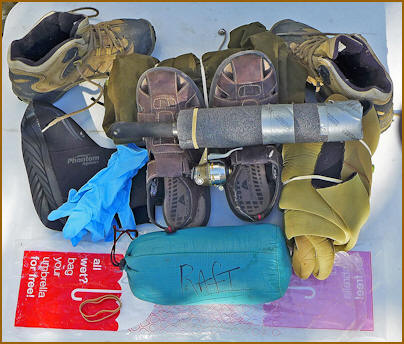
My wading equipment will
probably be different then most as I
rarely fish remote creeks during
Arizona summers. During summer,
things are easy because its warm
enough to wade and swim deep pools.
All one needs is their air sleeping
mattress to place packs on, for
swimming deep, steep pools. Once
done srap it to the outside of your
pack for complete drying. I always
use a trash compactor bag to line
the inside of my pack. They are
light, tough and protect contents
from rain/snow and wading accidents.
Rainproof pack covers never have
worked well for me.
During the winter things become more
challenging. Below are a few ways I
deal with cold weather, winter
wading. Carry an extra pair of light
wading shoes and change into them
for wading, thus keeping a pair of
shoes dry. I like using surfer socks
because they are tough,warm and
comfortable. |
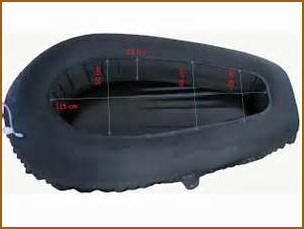
Supai Backpacking Lightweight Raft
|
Target stores offer
umbrella plastic bags for their
customers. They are used to place
dripping umbrellas in. I wear them
outside my socks, then inside shoes.
They are fairly tall and can be
secured with a rubber band around
ones leg to hold them up.
As evening sets in and if your feet
and pants are wet, find a camping
spot early. Start a fire to dry
clothes. I usually wear my sleeping
clothes, silk long underwear with
rain pants and merino wool socks,
while they are drying. As a last
resort Ill carry waders. I use an
old pair with just the legs that I
have cut off, or choose an
inexpensive pair of Orvis
lightweight waders.
If I know I will be encountering
deep pools that must be swam I will
use a lightweight Supai inflatable
backpacking raft. I never carry a
paddle but find a pole or 1/2 piece
of rotting log, that I use as a
paddle. Everything including myself
is placed in the raft. If you are
crazy enough to fish during cold
periods, be careful |
Flyfishing
System
 For Arizona’s
small fish I use a TFO 6' 9", four piece one
weight fly rod This rod goes into a short
florescent light holder for bushwhacking
protection although I have still broken it
twice. My current reel is a TFO BVK 0 fly reel,
loaded with a cut down two weight dry fly
line. For Arizona’s
small fish I use a TFO 6' 9", four piece one
weight fly rod This rod goes into a short
florescent light holder for bushwhacking
protection although I have still broken it
twice. My current reel is a TFO BVK 0 fly reel,
loaded with a cut down two weight dry fly
line.
In a small zip lock bag I carry the below
equipment as well as the reel. Some of this
equipment goes into shirt pockets once I get
to a bottom of a canyon or to flowing water.
-
Gink fly
floatant is placed in a smaller
ultralight bottle.
-
Small
fishing forceps with built-in scissors.
clipped to shirt.
-
1 Foam fly boxes
with magnets removed and rubber band for
closing.
-
I have my favorite
flies that cover most situations. If I
had to choose only one fly it would be a
parachute Adams for small trout.
-
1 extra leader
-
1 extra tippet spool
5x or 4x
-
2 strike indicators,
many times a larger dry fly
-
1 wool dry fly patch
usually placed on pack or shirt.
-
I do not use a
fishing vest or pouch for this kind of
fishing, Instead I find the Simms older
style Guide LS shirt works perfect for
this on the move creek backpacking
fishing. This shirt acts as a vest with
the four monster pockets. I can carry
needed flyfishing supplies in them and
it keeps my weight down. As you can see
there is no dress or accouterments
flyfishing statement made with this kind
of fishing. On the San Juan or Big Horn
rivers you would be frowned upon.
-
I do not use a net
except for when targeting bigger brown
trout. On creeks that hold larger brown
trout I will move up to a 5 weight with
3x leader/tippet. Much of this
kind of fly fishing for me is done after
midnight anyway. I simply
like fishing with lighter equipment and
have become quite accustomed to it.
My brown trout flies and tactics I have
always kept a secret.
|
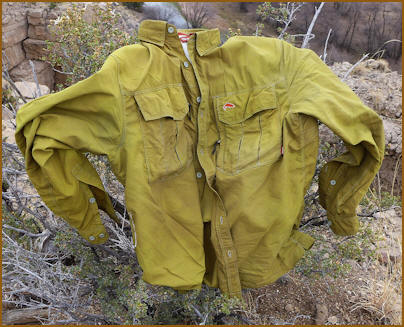
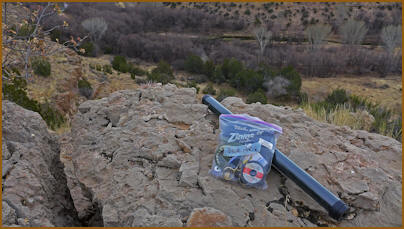
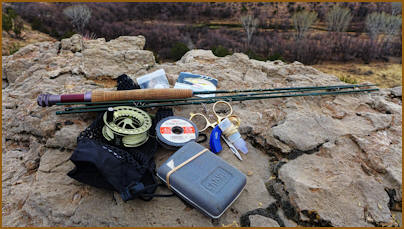 |
Spinning Outfit

If I know I will only need spinning
equipment for my trip I use a telescoping
rod that fits easily into a pack. I've tried
many telescoping rods and like the
Shakespeare Travel Mate in the 4' 6" size.
This is a bait casting rod so I grind the
finger hook off. For a reel I usually take a
Diowa Underspin 40XD although I have others.
The weight of a XD reel is 5 oz.These are
not the smoothest reels in the world but Im
not plastic worm fishing on Roosevelt Lake
either. These little reels I load with
spider wire line in 4 or 6 lb test. Always
remove the prespooled line they come with
because its usually poor quality and old.
Years past I always used open face spinning
reels but for backpacking I find they were
constantly unwinding line. Underspins
protect this line within packs as well as my
hard on equipment treatment.
All my lures and equipment go into a
double sided small Plano box. Below is what
I currently carry.
-
4 size 12
and 14 hooks
-
2 extra
treble hooks
-
4 small
split shot
-
4 swivels
-
6 zip ties
-
Mepps type
spinners
-
Small
twister tail grubs with weighted hooks
-
Extra
twister grubs & weighted hooks
-
2 small
floating lures
-
2 small
minnow lures
-
1 clear
bobber
-
1 regular
bobber
-
This box
weighs 4.2 ounces.
|
 |
Backpacking
gear
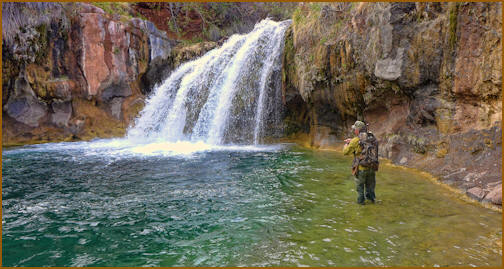 I subscribe to
modern day ultralight backpacking
principles. My gear is very specialized as
well as homemade and today there are many
cottage companies producing such equipment.
Gone are the days when I carried 50 to 60
pound packs into the wild. I simply adapt
current ultralight systems to my form of
canyoneering and fishing. My pack and
overnight base weight is 8.5 pounds. This
includes the pack, tent, sleeping system,
cook kitchen, personal hygiene, first aid,
down jacket, phone or gps, rain gear and
safety/emergency supplies. The only thing
not included is food, water and
alcohol stove fuel. The fishing system noted
above may change. I commonly treat water in
these locations since it is plenty full and
calculate how much I will need to get into
these canyons. Food usually adds 1.5 to 2
pounds per day depending how strenuous the
activity will be. As you can see everything
is very light thus allowing me to move fast
and comfortable. I subscribe to
modern day ultralight backpacking
principles. My gear is very specialized as
well as homemade and today there are many
cottage companies producing such equipment.
Gone are the days when I carried 50 to 60
pound packs into the wild. I simply adapt
current ultralight systems to my form of
canyoneering and fishing. My pack and
overnight base weight is 8.5 pounds. This
includes the pack, tent, sleeping system,
cook kitchen, personal hygiene, first aid,
down jacket, phone or gps, rain gear and
safety/emergency supplies. The only thing
not included is food, water and
alcohol stove fuel. The fishing system noted
above may change. I commonly treat water in
these locations since it is plenty full and
calculate how much I will need to get into
these canyons. Food usually adds 1.5 to 2
pounds per day depending how strenuous the
activity will be. As you can see everything
is very light thus allowing me to move fast
and comfortable.
Packs

-
Zpacks Arc
Blast
-
Osprey Exos
-
Badlands
Hypervent
-
Older REI
Flash
Mother Upland Bird Hunting Vest converted
into a fishing vest for close trips
Tents

One person cuben fiber tent. Enough room for
one person, gear and a dog. Tent is tied
upward to a tree limb. Tent weight 8oz.
Sometimes I don't carry a tent and only a
bivy to save weight if I know its not going
to rain or snow, or if bugs or critters will
not be a problem. I use tent tarps that do
not have a built in floor. Instead I create
my own light weight floor from Polycryo. The
two tents I have settled on are:
- Oware Drawcord
Bivysack 6 oz. Has a built in bugnet
- Oware sil
nylon 9x9 Pyramid Tent, room for two
people and gear... 21 oz
- Bear Paw
Designs cuben fiber Lair one person tarp
tent... 8 oz, room for me, dog and gear
- Pyranet 1
cuben fiber bath tub bug net tent. Will
fit under either tent if the bugs are
bad or can be used by itself. 8 oz. Only
room for 1 person
Note: These tents do not use poles, but
instead utilize hiking sticks which I rely
on to get me in and out of canyons. A wooden
stick can also be used or tied upward to a
tree limb.
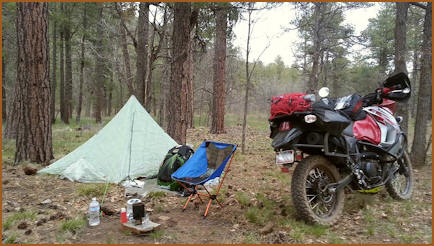
You can also use an off road vehicle to
get you close to the canyon side walls, set
up a base camp there and use daylight to
access a specific part of the canyon. One
can quickly pull camp, move to another area,
set up a base camp again and do the same
thing over and over. This can work good if
you don't want to sleep in the bottoms of
deep canyons.
Sleeping
systems
I don't use a sleeping bag unless its below
freezing, but instead prefer a down quilt. I
have experimented with hammocks but they can
be cold sleeping in cooler temps.
- Gossamer Gear
Thinlite pad 8 oz.... or a Therm-a-rest
Neo air mattress 12 oz
- Hammock Gear
Burrow 40 quilt. 17 oz
- Western
Mountaineering 20 degree down sleeping
bag, 1 pound 13 oz. Used during below
freezing temps
- Goosefeet Down
Booties 2 oz
Note...I use the same sleeping/ tent
systems for camping from a motorcycle, ATV
or backpacking.
Locating
Possible Fishing Locations
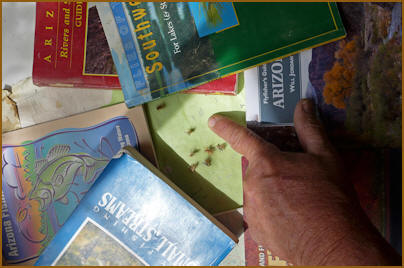
I've mentioned before how to locate
possible fishable canyons. Look over maps,
possible routes in and out, stable springs
and use Google Earth to evaluate them.
Evaluate old records and ask questions. Look
for large upstream water catchments.
Getting There

Next decide the best method to get you
close for hiking. This could involve an ATV,
4x4 vehicle, motorcycle, horse or mule. Ask
a friend to join you and plan the rest of
the trip. You may find you were wrong or
maybe find a real hot spot!
Tactics
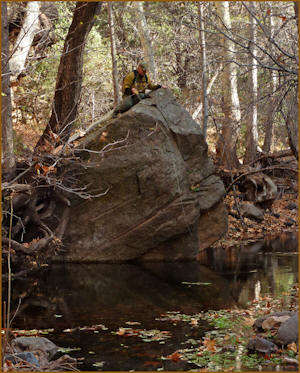 Small creek
fishing is very simple. Most Arizona small
creek fish live in pools. I hike until I
reach potential pools and take a moment to
watch the pool for rises or look for fish on
the bottom. Once located the first cast is
usually the most important one so I try and
get it right. With large trout this is
critical. With smaller fish not so much and
most are eager to take a fly. With small
fish, fly selection is usually not as
important unless there is a hatch going on.
At first they will take anything but once
released they run back to their friends and
spread the word fast and the bite quickly
dies. Just kidding but it sure seems like
it. If you cant see any fish or activity,
bigger fish usually occupy the best spots
within a pool. Try there first. Small creek
fishing is very simple. Most Arizona small
creek fish live in pools. I hike until I
reach potential pools and take a moment to
watch the pool for rises or look for fish on
the bottom. Once located the first cast is
usually the most important one so I try and
get it right. With large trout this is
critical. With smaller fish not so much and
most are eager to take a fly. With small
fish, fly selection is usually not as
important unless there is a hatch going on.
At first they will take anything but once
released they run back to their friends and
spread the word fast and the bite quickly
dies. Just kidding but it sure seems like
it. If you cant see any fish or activity,
bigger fish usually occupy the best spots
within a pool. Try there first.
My small creek
casting tactics would probably be frowned
upon by the National Federation of
Flyfishers. It is pretty much what ever
works to get the fly out there. Two casts I
often use are the bow and arrow cast and
roll cast. Of course if there is room
traditional casting. But often climbing rock
ledges and carefully dropping flies below
into good areas, works great. Once a pool
shuts down which is usually less than 5
minutes, I move on to the next pool. Eddies,
beaver dams, creek turns can have areas of
water that is not moving, where fish may be
also. Remember fish don't want to work real
hard and will choose the easiest places to
make a living. Usually a pool where they do
not have to constantly expend energy. Each
stream has its own character and uniqueness.
Unless the pool is very large or I'm going
to take a break I leave my pack on and fish.
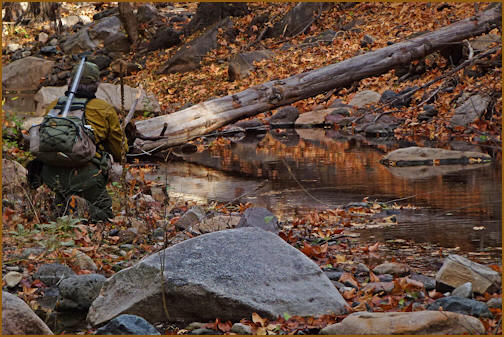 Plan on getting
your feet wet. I normally do not carry waders with
me. I cross where its safe to do so and wade
in cold water. Many times this may mean
partially climbing out of the canyon to
continue upstream. Oh that's right I usually
fish up stream. Sometimes a route in does
not allow this though. In creeks that have
slippery bottoms I use screw in cleats to
aid in walking. Carry extra socks to change
into later. You may choose a lightweight
river shoe for walking in water. I also like
suffer neoprene booties. Another thing that
works is the next time you are in a Target
store, take a few umbrella plastic bags that
they place out front, for customers to place
their leaky umbrellas in. These fit feet
perfectly and are tall. These actually work
pretty good when wearing them outside your
socks, inside shoes and a rubber band around
the upper leg will hold them up. Plan on getting
your feet wet. I normally do not carry waders with
me. I cross where its safe to do so and wade
in cold water. Many times this may mean
partially climbing out of the canyon to
continue upstream. Oh that's right I usually
fish up stream. Sometimes a route in does
not allow this though. In creeks that have
slippery bottoms I use screw in cleats to
aid in walking. Carry extra socks to change
into later. You may choose a lightweight
river shoe for walking in water. I also like
suffer neoprene booties. Another thing that
works is the next time you are in a Target
store, take a few umbrella plastic bags that
they place out front, for customers to place
their leaky umbrellas in. These fit feet
perfectly and are tall. These actually work
pretty good when wearing them outside your
socks, inside shoes and a rubber band around
the upper leg will hold them up.
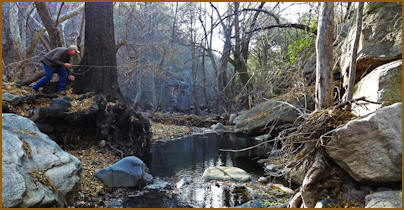
Be sneaky when moving up on a pool. Here
Tom uses a tree for cover.
Safety
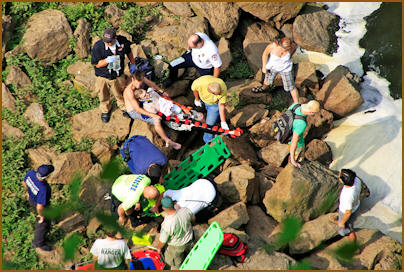
Canyon Rescue
Always tell someone where you are going
and when you plan on returning. Consider
using a Spot rescue receiver. Never venture
into canyons during monsoon or spring snow
melt. Consider debarbing all your hooks for
yourself not only the fish and I speak from
experience here. Don't take unnecessary
risks and be more careful . Where you enter
the canyon bottom, mark this area well with
something you will recognize when its time
to exit. Use a GPS or smart phone back
country app to track your self so you don't
become lost. Carry an extra battery for
this. There are some areas where wild trout
populations reside such as in the Sierra Ancha mountain range, that also have hi bear
density populations. Practice bear safety
rules and further wash up as good as you can
each night before bed, thus removing fish
smell from your hands. Consider carrying the
extra weight of bear spray. Never sleep
overnight in canyon bottoms, instead sleep
above the canyon. You will stay warmer this
way as well as safe.
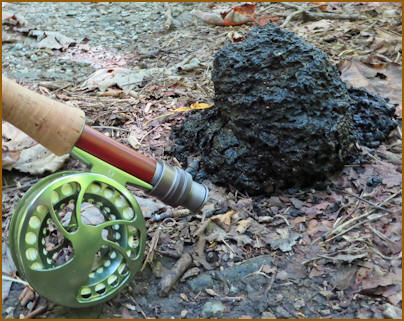
Bear Scat
Applying Canyoneering Fishing Elsewhere

Wild brook trout from high in the Smokey
Mountains, TN
I enjoy this kind of fishing so much that
I apply the same principles in other states
such as Colorado, Montana, California,
Tennessee and Wyoming. Last year for
instance I had a short photo job in
Tennessee and planned a week long
backpacking route in the Smokey mountains
pursuing wild brook trout. I logged over 50
miles hiking up canyons exited certain
points, caught a hiking trail over to
another canyon and did the same thing. I
never ran into a soul except on some well
traveled trails. The fishing and scenery was
fantastic with the only problem being,
dealing with black bears, in one area over
night.
Put them back

Lastly I always
put the fish back I catch. Sometimes Ill
keep sunfish or bass and make them an
evening meal. Most Arizona remote creeks are
simply to sensitive to keep fish. When you
find a stream that contains wild fish keep
it a secrete. If you share the location on
average each person will share it with seven
other people and they will share it with
seven more and......, well before you know
it your little stream is fished out. The
only reason these places still exist is
because of their remoteness and not telling
others.
I hope I have
answered future questions on this page.
Travel safe and with someone when you go
canyoneering fishing. Consider sending us a
photo of a wild fish you caught in the
future. Don't tell us where though.
 |



